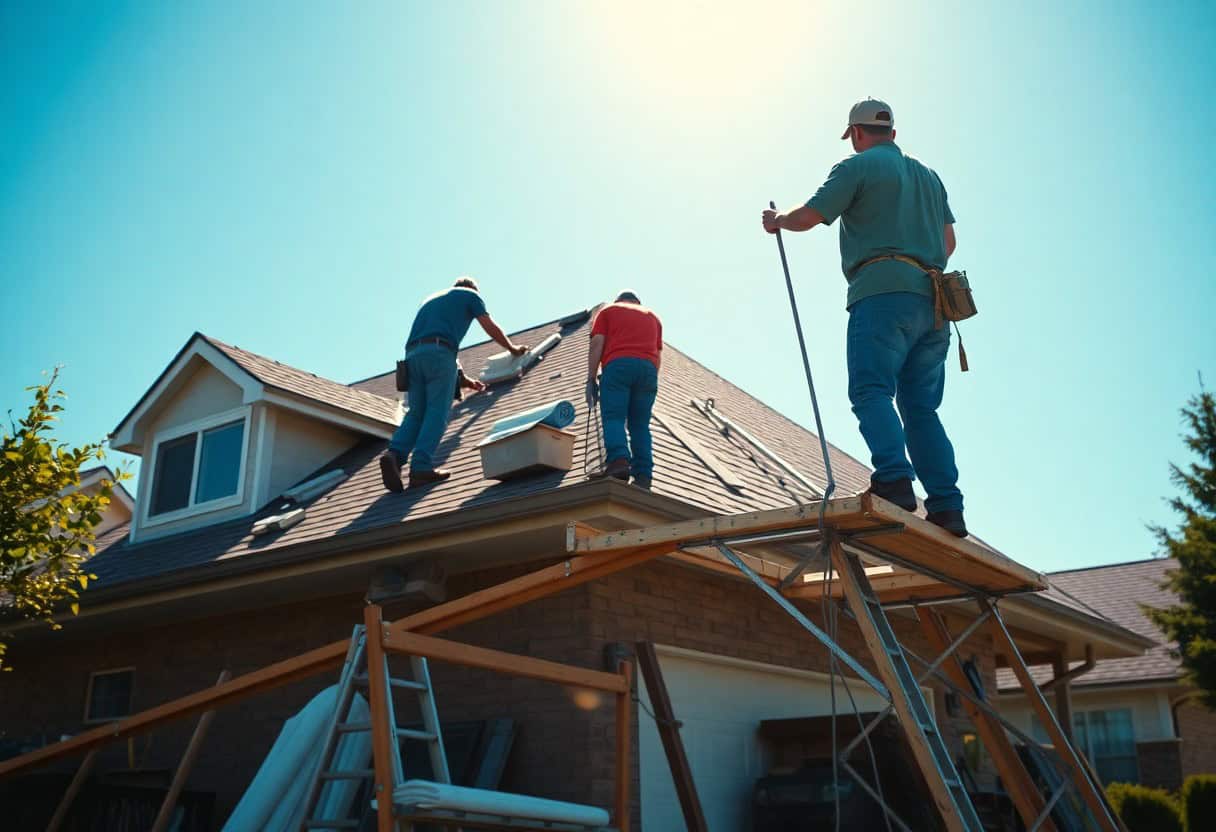How long will it take to install a new roof?
Fill Out The Form And We'll Get Back To You

Most homeowners are eager to know the timeline involved in installing a new roof. Understanding how long this process takes can help you better plan for the project and manage your expectations. Factors such as the size of your roof, the type of materials being used, and the weather conditions often influence the overall duration. In this article, we will research into the key elements that will determine how long you can expect your roofing installation to take, ensuring you have all the information needed for a smooth transition.
Factors Influencing Installation Time
A variety of factors can significantly influence the time it takes to install your new roof:
- Roof type
- Weather conditions
- Roof size and complexity
- Accessibility of the property
- Experience of the roofing crew
After considering these factors, you’ll have a clearer understanding of the timeframe for your roof installation.
Roof Type
Installation times vary greatly depending on the roof type you choose. Different materials and designs can impact how long the process takes, with some roofs requiring more complex installation techniques than others.
Weather Conditions
By being aware of the weather conditions, you can better anticipate potential delays during installation. Rain, snow, or extreme temperatures can hinder roofing work, making it important to factor in local climate trends.
Understanding the local weather patterns can enhance your planning for the installation of your new roof. For example, scheduling work during a dry season can lead to a more efficient process, while unexpected storms can pause operations, extending the overall timeline.
Roof Size and Complexity
Behind every roof installation, size and complexity play a significant role in determining the length of the project. Larger roofs or those with intricate designs often require additional labour and time to complete properly.
But addressing the size and complexity of your roof upfront allows for more accurate timelines. If you possess a steep pitch or multiple facets, specialised techniques may be necessary, leading to lengthier installation times compared to simpler, flat roofs. Being aware of these details ensures you are well-prepared for the process ahead.
Typical Installation Timelines
Clearly, the duration for installing a new roof varies depending on several factors, including the type of roofing material, the size of your property, and the weather conditions. Generally, a complete roof installation can take anywhere from a few days to a couple of weeks. It’s important to consult with your roofing contractor to gain a more specific timeframe tailored to your situation.
Asphalt Shingle Roofs
At the same time, asphalt shingle roofs are among the quickest to install, often completed within a few days for an average-sized home. Their relatively light weight allows for easier handling and quicker application, reducing the overall installation time.
Metal Roofs
Installation of metal roofs typically requires more time due to the complexity of the materials and the need for precise fitting. On average, you can expect the process to take between a week and ten days, depending on the intricacies involved.
And, while the installation of metal roofs may take longer, the benefits they offer often justify this extra time. Metal roofing is incredibly durable and can last significantly longer than traditional materials, potentially saving you money on future repairs and replacements. Moreover, their energy efficiency and modern aesthetic can enhance your home’s value and comfort.
The Role of Professionals vs. DIY
Keep in mind that deciding between hiring professionals and undertaking a DIY project can significantly impact both the duration and quality of your roof installation. While DIY can be a cost-saving option, the expertise and efficiency of professionals often lead to a quicker and more reliable outcome.
Benefits of Hiring Professionals
Among the advantages of hiring professionals is their extensive experience and specialised knowledge. They are familiar with local building regulations, have access to necessary tools, and can identify potential issues that may not be obvious to you. This ensures that the job is completed correctly and to a high standard, saving you time and stress in the long run.
Time Considerations for DIY Projects
Beside potential cost savings, DIY projects can consume a significant amount of your time and effort. The lack of experience may lead to errors that require rework, further extending the time needed to complete the installation.
Due to your personal commitments and experience levels, DIY roofing projects often take longer than anticipated. If you are unfamiliar with the process, the learning curve can add unnecessary delays. Additionally, without a team of experienced hands, completing the project alone may stretch over several weekends or even weeks, especially if unforeseen issues arise. Balancing your daily responsibilities alongside a full roof installation may lead to frustration if you are not well-prepared for the time investment required.
Permits and Regulations
Unlike minor home improvements, installing a new roof often requires permits and adherence to local regulations. These requirements vary significantly depending on your location, meaning you should check with your local building authority before commencing work. Failing to obtain the necessary permits could lead to delays or fines, so it’s wise to do your research early in the process.
Understanding Local Building Codes
Behind every roofing project, local building codes dictate specific materials and procedures that must be followed. Familiarising yourself with these codes ensures that your new roof is safe, compliant, and up to standard, which can prevent future issues should you decide to sell your property.
Impact on Timeline
With the potential need for permits and inspections, installing your new roof may take longer than anticipated. You will likely need to account for the time it takes to secure these approvals and schedule inspections, all of which can add several days or even weeks to your project timeline.
But these delays are not without their benefits. By taking the time to follow local codes and regulations, you ensure that your roof is compliant, potentially increasing your property’s value and desirability. Additionally, having everything in order may save you hassle down the line, especially if you ever plan to sell your home or complete further renovations. Patience in this phase can pay dividends in the long term.
Preparing for Installation
For a smooth roof installation, you need to ensure your property is ready for the process. This involves clearing the area around your home and informing your neighbours of the upcoming work. You may also want to remove any roof decorations or items, such as antennae, to avoid damage during the installation. Adequate preparation helps the roofing team work efficiently and minimises disruptions.
Pre-Installation Checklist
Against common belief, executing a pre-installation checklist is necessary to avoid delays. First, verify that your chosen roofing contractor is licensed and insured. Ensure all necessary permits are obtained, and prepare your home for potential noise and debris. Additionally, you should discuss start times and expected duration with your contractor.
Addressing Underlying Issues
Preparing to address underlying issues is key to ensuring your new roof performs well. If there are pre-existing problems like leaks or structural damage, these need to be rectified before installation begins.
For instance, if your roof has a significant leak, it’s imperative to identify and fix the source of the problem to prevent damage to your new roof. You should also inspect the existing decking for rot or mould, as these issues can compromise the integrity of your new roofing system. By tackling these problems upfront, you can ensure a longer-lasting and more effective roofing solution.
Post-Installation Considerations
Not only do you need to focus on the installation of your new roof, but it’s also vital to take into account what comes next. This includes a plan for ongoing maintenance to ensure your roof remains in optimal condition. Furthermore, you may be curious about how long does it take to tear off and replace a roof? This can aid in your future roofing projects or upkeep strategies.
Inspection and Maintenance
After your new roof has been installed, it’s important to schedule regular inspections and maintenance. This will help you promptly identify any potential issues and keep your roof in excellent shape for years to come.
Final Cleanup Process
About ensuring your property is clean after the installation, the final cleanup process is an imperative step. A thorough clean-up will help remove any debris and materials left over from the installation.
The cleanup typically includes the removal of any leftover shingles, nails, and other materials from your yard. You may also want to check gutters and downspouts to make sure they’re clear of debris. A well-conducted final cleanup not only enhances the aesthetic appeal of your property but also safeguards against potential hazards associated with stray nails or sharp objects.
Summing up
So, when considering how long it will take to install your new roof, you should expect the process to typically range from a few days to a couple of weeks. Several factors influence this timeline, including the size of your roof, the type of materials used, and the weather conditions at the time of installation. By planning ahead and choosing experienced professionals, you’ll facilitate a smoother and more efficient roofing project, ensuring your home is well-protected in no time.
FAQ
Q: How long does it typically take to install a new roof?
A: The time it takes to install a new roof can vary significantly depending on several factors, including the size and complexity of the roof, the type of materials chosen, and the weather conditions. Generally, a straightforward roof replacement can take anywhere from one to three days. Larger or more intricate roofs might require a week or more to complete.
Q: Does the type of roofing material affect installation time?
A: Yes, the type of roofing material can impact the installation time. For instance, asphalt shingles are generally quicker to install compared to materials like slate or metal, which might require more intricate work and therefore take longer. Additionally, the skill level and experience of the roofing crew can also affect how long the installation will take.
Q: What weather conditions can delay the roofing installation process?
A: Adverse weather conditions, such as heavy rain, strong winds, or snow, can significantly delay the roofing installation process. Roofing crews usually prioritise safety and will postpone work if the weather conditions are not suitable for roofing tasks. It is advisable to consult with the contractors regarding the expected timeline and any potential weather-related delays.
Re-Roof of Bungalow
The team made a fantastic job of replacing the roof on our bunglaow. They were fasy, reliable and excellent value for money.
Chimney Removal
We employed Wrights Roofs to take down our very old chimney – tht had seen better days. They carefully removed and made good the area where the chimney was. Really impressed.
New Roof
We had an extension built and Wrights came and put a new roof on. They were brilliant, no fuss, great value for money. Thank you.
Roofs, Flat Roofs Chimneys and Solar Panels
If you need roof work on your home, please complete the form or call us today.

